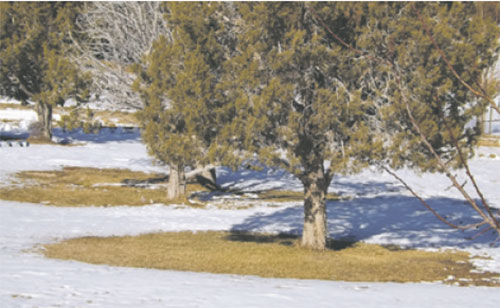
The dense foliage of these junipers shows how snow is captured and evaporates directly without melting to water the soil, trees and grass. Pine, spruce and firs do the same when they are too thick. Photo by Dexter Gill
OK, turn on the water, fill it up! Let’s get the boat in the water!
People that have grown up with a residential water system tend to take good water for granted. You turn the tap at the sink, and you expect water to come out.
You expect water in the lake for skiing and fishing. Farms with irrigation depend upon there being water in the ditch.
Water is essential for life to exist. Seventy-one percent (71 percent) of the earth is covered with water, yet only around 2 percent of the water is suitable for man, wildlife and vegetation. That is for plants, insects, bacteria, wildlife, and MAN!
All life relies on water being available from rain directly, or stored in catchments and the aquifer, or snow melt in rivers. The average man can only live about three days without water. Man can only live about three weeks without food, which also requires water. The average family of four uses about 146,000 gallons per year. Water is pretty important stuff to be taken for granted as as we do!
Where does your water come from? Other than a small number of private wells, the vast majority of drinking and irrigating water to sustain Montezuma and Dolores Counties comes out of the Dolores River and McPhee reservoir. Of great concern should be the quantity and quality of the water that makes it to the lakes for distribution and treatment.
Where does our water start? Mostly as snow in the San Juan National Forest from Lizard Head Pass west, and east along the crest of the watershed. This is the Dolores River watershed, which is composed of only 512,000 acres to provide all the water for the river and McPhee Reservoir. It takes 275,482 acre-feet of water (1 acre-foot is the amount of water covering an acre 1 foot deep, about 325,851 gallons) to meet the Four Corners water rights needs, clear to Dove Creek, which also includes 31,798 acre-feet dedicated for downstream fishery. That means there must be 176,000 gallons of water produced as runoff, on every single acre of the watershed, going into springs, streams and rivers every year, AFTER soil recharge, trees and other vegetation needs are met.
If we want to ensure a good flow of water, we have to manage to keep the forest healthy and productive to meet the needs of all the life forms depending upon it.
The trees have the single biggest impact on water and other life forms. The trees help protect the soil and lower vegetation and produce oxygen and moisture for the local air quality. However, if the trees are too thick they shade out the grasses and flowering plants and shrubs that elk, deer and other wildlife need for food.
When we get stuck in the snow, we don’t think about the fact that the trees actually catch rain and snow in their branches, where up to 45 percent of that moisture directly evaporates without ever making it to the ground or your faucet. The water that does make it to ground can be used up by each tree at an average of 10 gallons per tree per day, sometimes more. Our forest has around 100 to over 1,000 trees per acre in places. That is using a lot of water, just to meet the forest need.
When the trees are too thick, as they are now, with there being up to 10 times too many trees in much of the forest, there is not enough water to keep that many trees healthy and also support grass and shrubs, and maintain springs and streams.
The end result is we have a weakened, unhealthy forest, desperately needing to be thinned out to improve forest health, water availability for other plants, wildlife, man, and recreation!
An unhealthy forest results in insect and disease damage followed by wildfires. That results in wasted resources, soil damage, and excessive erosion with burned ash clogging stream beds and the fishery habitat, all the way to the reservoirs and even, into the water treatment facilities.
Responsible watershed management demands the forest be actively managed to ensure a future healthy forest, producing maximum water, timber and forage for all. Do you want water at your tap, for food, wildlife and recreation? The state and local counties that depend on the water and forest resources are the ones that know best how the local forest needs to be managed, not some politicians in New York and Washington, D.C.
Editor’s note: A local group called the Dolores Watershed Resilient Forest Collaborative, or DWRF, meets regularly to discuss ways to enhance the health of the watershed.
Dexter Gill is a retired forest manager who worked for private industry, three Western state forestry agencies, and the Navajo Nation forestry department. He writes from Lewis, Colo.

